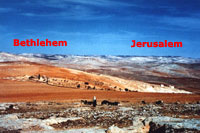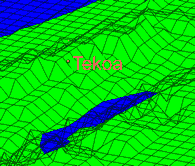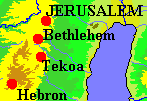HISTORICAL RECORD: Winter Months Grazing for Sheep in Bethlehem area
The following is from Bible Study notes and Biblical commentaries by Dr Tim Bulkeley Tekoa was in the vicinity of Bethlehem and would have not only had the same flock grazing methods but would have shared some pasturage with the shepherds headquartered in Bethlehem. This is from material about the prophet Amos.
Many say that it was too cold for the shepherds to be tending their flocks in December in the vicinity of Bethlehem. However this area has average lows about the same as Lake City, Florida, is warmer than where Jacob tended Laban's flocks and it is where the forage would have been.
 Tekoa, on the Eastern slopes of the Judean hills, is most often
identified as the modern Khirbet Taqu`a. (See map on left.) This
region is on the edge of the rain shadow of the higher hills to the west,
and was therefore too dry for reliable cultivation.
Tekoa, on the Eastern slopes of the Judean hills, is most often
identified as the modern Khirbet Taqu`a. (See map on left.) This
region is on the edge of the rain shadow of the higher hills to the west,
and was therefore too dry for reliable cultivation.
From the hills of Taqu'a Bethlehem (about 8Kms north) and Jerusalem (twice as far
again) can just be seen. The main road south along the ridge is not far off,
and a small route leads down to the Dead Sea near En Gedi (the "Ascent of
Ziz"). 
The descent from the Judean ridge to the Dead Sea forms a series of broad "steps" (see the wireframe 3-D map right).
 Though this area is dry, there is sufficient vegetation to allow grazing for part of each year. In
the winter flocks are grazed on the lower "terraces" and in summer on the
high ground above Tekoa.
Though this area is dry, there is sufficient vegetation to allow grazing for part of each year. In
the winter flocks are grazed on the lower "terraces" and in summer on the
high ground above Tekoa.
The probability that the sheep farmers of Tekoa in Amos' day were semi-nomadic removes one of the most telling objections to this
identification of Tekoa. For, while it is true that Sycamore figs (see Amos 7:14) do not grow and fruit in the highlands, they are found lower near
the Dead Sea.
In any case 7:12 seems to suggest a Southern origin for the prophet. As does the choice of language to speak of Amos as prophet, cf. esp 7:12 (hozeh) and 14 (nabi').
Despite the mention of Tekoa as a "city" built by Rehoboam for Judah's defense (2 Chron 11:6) there is little evidence that the site was a town, although investigations, including a brief dig under the auspices of ASOR in 1955 show the area was inhabited in this period.
A cave was excavated (a tomb?) where among other finds were lamps and pots with the shape and style typical of the pre-exilic, "Iron II" period (1000 BCE - 586 BCE).
Pottery from cave at Khirbet Taqua, above and below right, and lamps also from the cave, left, note their typical "pinched spout" shape (Clifford).

